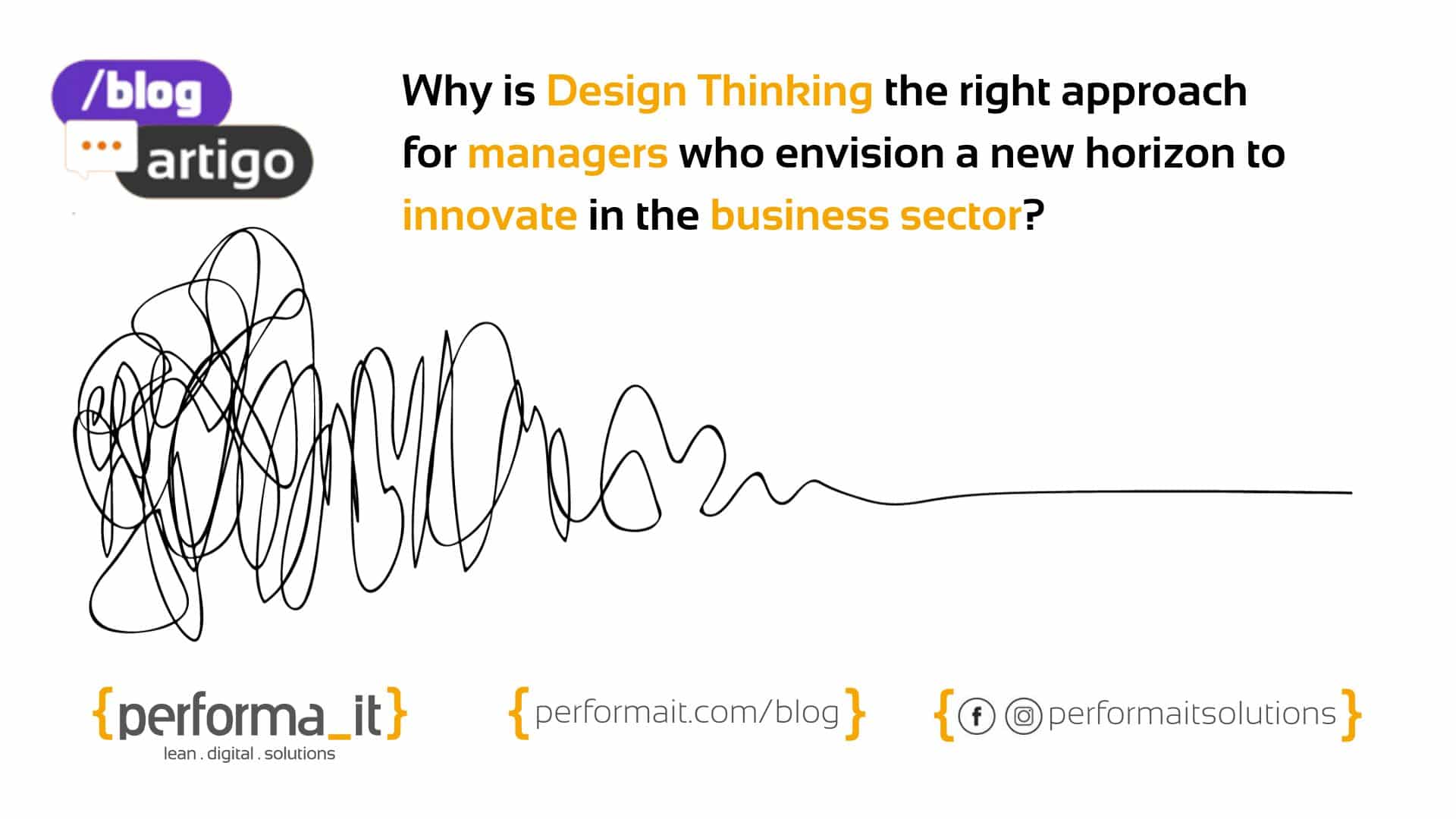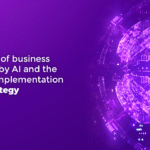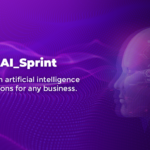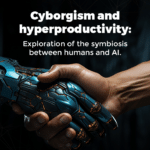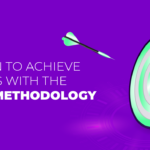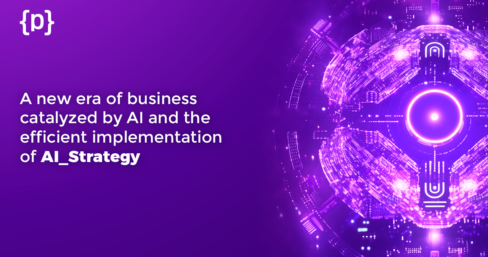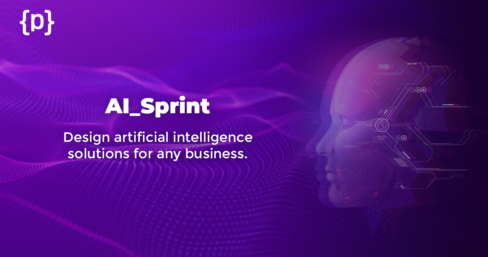Learn more about this approach that can help achieve better results, with maximum efficiency and minimum errors in generating and organizing ideas for solutions to problems faced by the company.
Innovating and finding creative solutions to common problems can be challenging for any corporation. There are many questions, and a common way of using this approach is developing new products and services: Will they be well accepted? Will sales succeed? Is there a market for it?
Focusing on design thinking principles is an excellent path to solving real problems faced by real people. It meets the challenges of those who launch new products in the market and focuses on needs and solutions that are still emerging.
The Design Thinking approach emerged to assist this process and avoid launching something that people do not need or do not want and that it may not please the final customer.
And if you need to master the application of Design Thinking, don’t worry! We have prepared an article telling you the reasons for the success of this work process that has been conquering a lot of space to create a more cooperative environment in search of solutions.
What is Design Thinking?
The most important thing before we start is to highlight that we are talking about a creative strategy focused on finding new solutions to complex problems. An approach that is human-centered and based on how human beings interact with their environment and demands to create and develop innovative products or services.
Design Thinking is an evolution of Design theory first used in the 1960s. The term became popular through the early methodological processes of David Kelley, one of the founders of IDEO – the most famous Design agency – which made more accessible the philosophy that claims that any professional can use Design Thinking to solve complex problems.
A mindset that refers to “design thinking” means that before implementing any solution – whether a product or a service – we need to know the needs of the ‘pains’ of the people who possibly will use it.
The assumptions are left aside to give way to differentiated ideas and insights derived from observing the consumer needs, desires, and limitations, inspired by the creativity and breadth of the designers thinking through new ways of solving actual problems, reducing costs, and increasing sales.
The reference to ‘Design’ is only symbolic, as the professionals who conduct Design Thinking have a multidisciplinary and diversified performance, based on the assumption of being focused on the consumer, naturally trained to develop disruptions.
The Design Thinking Characteristics
Design Thinking helps to ensure formats that adapt to the needs of consumers – it can be the improvement of an existing product or service – to meet the demands and add value to the consumer.
It is necessary to be inserted in an environment that favors the development and creative exploration of the solution, creating a sustainable connection between the material and its user and it can be used in any business model, irrespective of the industry or segment.
Among the main characterizing elements, we can mention:
- Focus on user experience;
- Critical and flexible sense in terms of changes;
- Search for the right questions that lead to assertive solutions to intriguing problems;
- Collaborative aspect, which generates synergy between teams and connection with customers;
In a scenario in which companies need to add intelligence and competitiveness and make assertive decisions, it is quite a tool! The corporate world cannot escape innovation, investing in digital transformation, and betting on connecting with people. These are objectives that Design Thinking fulfills very well, which justify its remarkable rise as part of the routine in most different businesses, mainly when they focus on fostering disruption.
A strategy widely used in startups
Design Thinking is a strategy widely used in startups, mainly because it is a flexible approach that helps to find solutions to problems through new products and services.
It is the best strategy in a path that seeks to escape the conventional commercial methods – which demand time and money – based on planning and project management methodologies capable of providing innovative support.
This focus, very typical of Design Thinking, came as a disruptive way of conducting projects and ideas, breaking a paradigm about the methods used in more traditional businesses. It shortens the path in the product or service cycle development, leading it to reach the customer in less time. And what is most relevant is the elimination of related uncertainties, which already validate the feasibility of the business.
It is an accelerated cycle and fully aligned with the profile of startups, whose interest is to ensure that the offer of solutions has greater assertiveness concerning the market, taking lesser risks. People’s needs change quickly, and wasting time can cost the company’s success, as sometimes the solutions offered are not even an actual need.
How to apply Design Thinking
To apply Design Thinking in the development of solutions and validation of ideas, some fundamental steps have to be followed which may vary from one process to another. But basically, the different phases of the methodology consist of the following:
- Immersion;
- Context Analysis;
- Observation;
- Definition;
- Search for problems;
- Ideation;
- Sketch development;
- Prototyping;
- Testing;
- Iteration;
- Evaluation.
Participants are placed in a real challenge scenario, for which they will seek a solution during the immersion process, and thereby understand and execute the principles of Design Thinking in a simple and easy to apply way.
Based on the real challenge, everyone is immersed in the consumers’ context to understand their experience, their needs and desires regarding the product or service, to then design innovative solutions to demonstrate and test with the consumer, validating the solution.
Where to find opportunities to innovate?
Design Thinking keeps the client in the spotlight of its practices, as it understands that a particular problem refers to a person and, therefore, needs to be solved to make their life easier – that generates value.
But how to find out what these problems and needs are?
This is the question that helps to identify opportunities for innovation and to answer it, it is necessary to be aware of what is happening in the world and how it evolves to solve problems that arise in people’s lives according to the progress of technology, with tools that favor this process.
The following are classic Design Thinking tools:
• CSD Matrix: aligns the team and obtains in-depth understanding of the problem
• Empathy interview: gets to know the consumers and understands their needs
• Brainstorming: generates innovative ideas for the problems identified in the previous stages
All these tools generate fundamental ideas and insights to develop products and services based on users’ needs and perceptions.
Application of Design Thinking by Performa_IT
It is important to emphasize that Design Thinking is not a t inflexible approach as it is common to associate it with ready and tested formulas to apply in any case without distinction.
There has to be the freedom of consideration in order to find solutions in a collaborative way, improving creativity, leaving the comfort zone, without fearing obstacles to conceive something better and innovative.
Our proprietary work methodology, named IDEA-PAD, combines the principles of Design Thinking, Lean and Agile, providing well-defined stages and deliverables, guiding the design and development process.
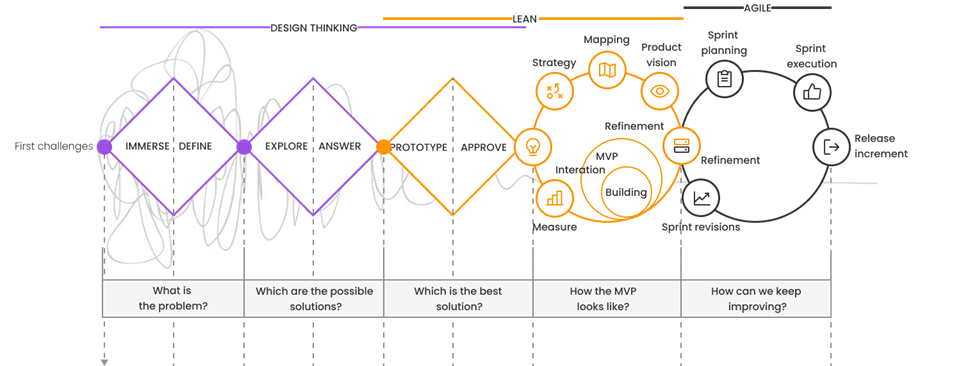
The facilitator – a professional who leads the multidisciplinary team during Design Thinking – adapts the tools and stages to the project, participants and consumers – that is, the process is flexible and customizable.
We go from Immersion to Prototyping, collecting direct feedback from the final customer that allows us to analyze the solution feasibility with ongoing measuring and learning, building each stage through agile development. We seek to elevate this attitude to the maximum, starting from an initial challenge, helping to define the real problem to be solved by the company, exploring the customer’s journey and mapping the pains and possible solutions, highlighting the search for an immersive attitude in all of the customer’s professional relationships.
The goal is to create maximum empathy with the end user, as people’s needs are the main reason for developing a project.
A collaborative work that includes an entire multidisciplinary team to find innovative solutions. Different angles approached by the team members, offering varied interpretations on the issues that provide more assertive contribution to the result, seeking to understand each view, identifying barriers and finding the best alternatives to overcome them.
We take our commitment in each project, as they must be seen as an enterprise, going beyond the development of their functionality. The entrepreneurial perspective guarantees products and services to meet a specific need, solve a problem, achieve goals and differentiate in the market, supporting growth management and leveraging innovation.
For us, every project needs to evaluate investments according to the return that can be obtained through them. That is how Design Thinking stands out: its implementation cost is extremely low, while the competitive advantage it generates is huge.
Therefore, the first reason to invest in this approach is the fact that it is the necessary differentiator for your company to be placed ahead of competitors and, ultimately, this is an extremely efficient approach for finding answers to the most important issues of the business, and can be used in any market segment, in personal life and in several other areas, by anyone who is familiar with the technique.
Does your company already use this innovative and disruptive approach to develop new solutions? If not, the time to start it is right now.
Talk to us!
